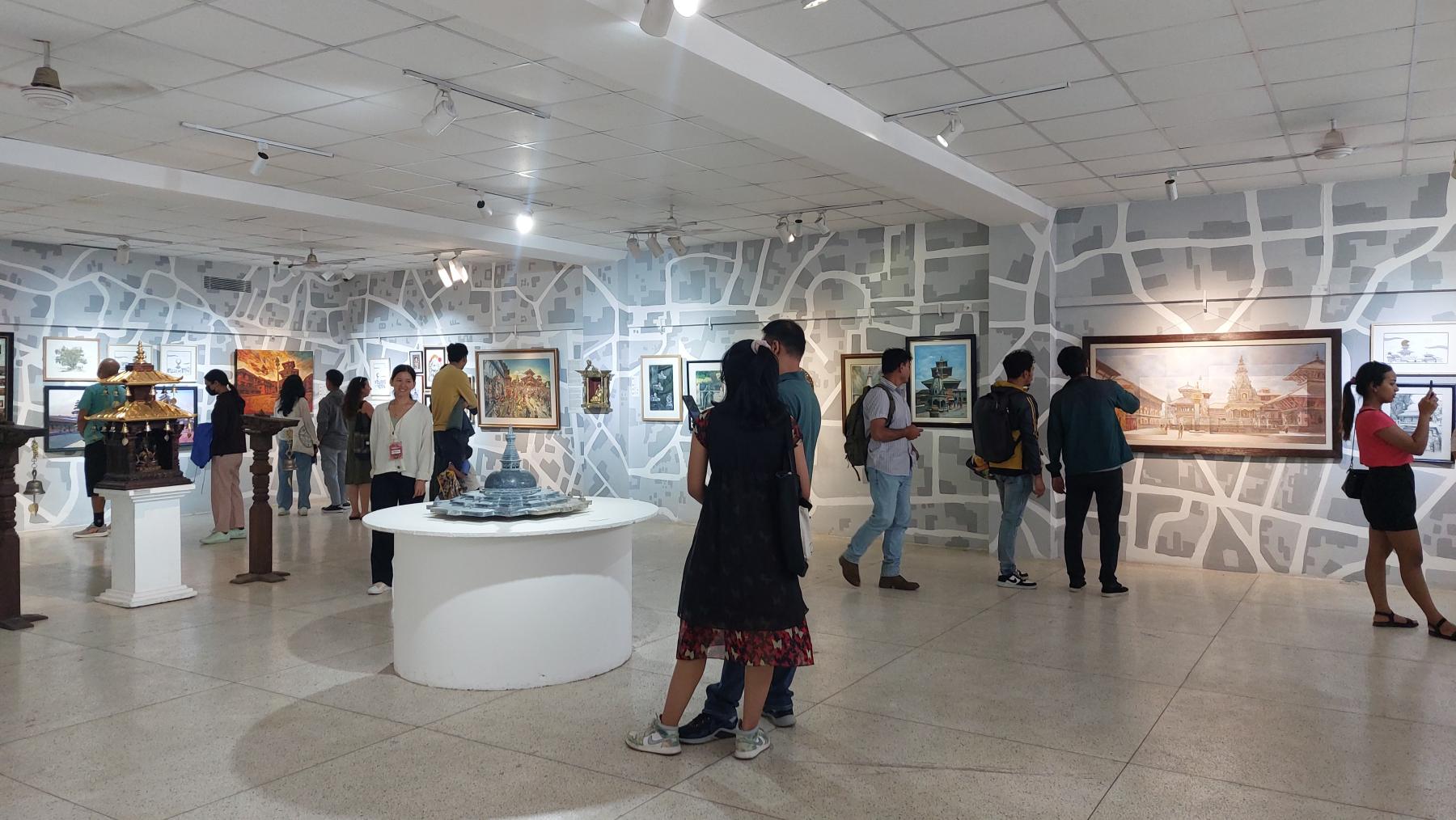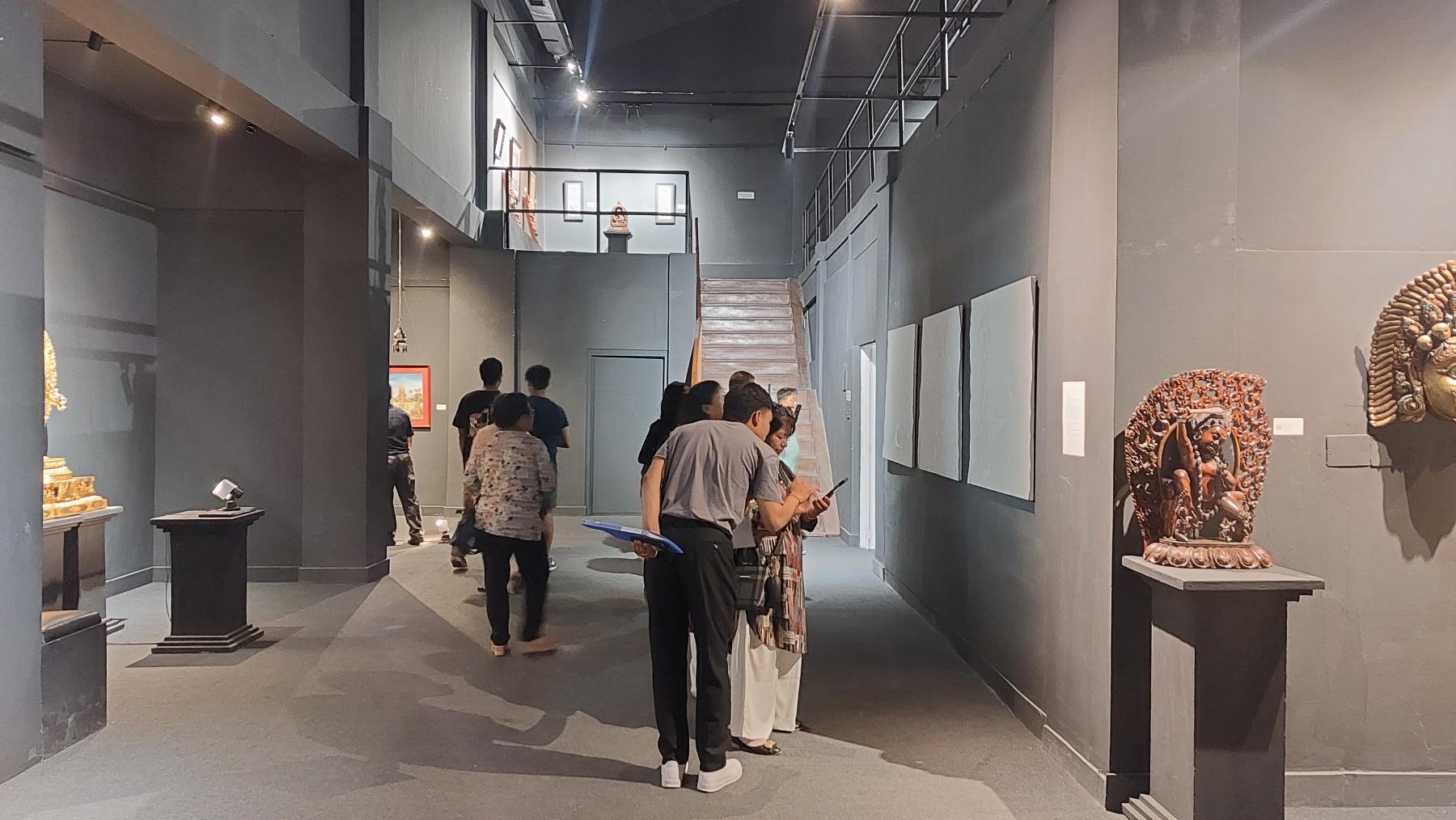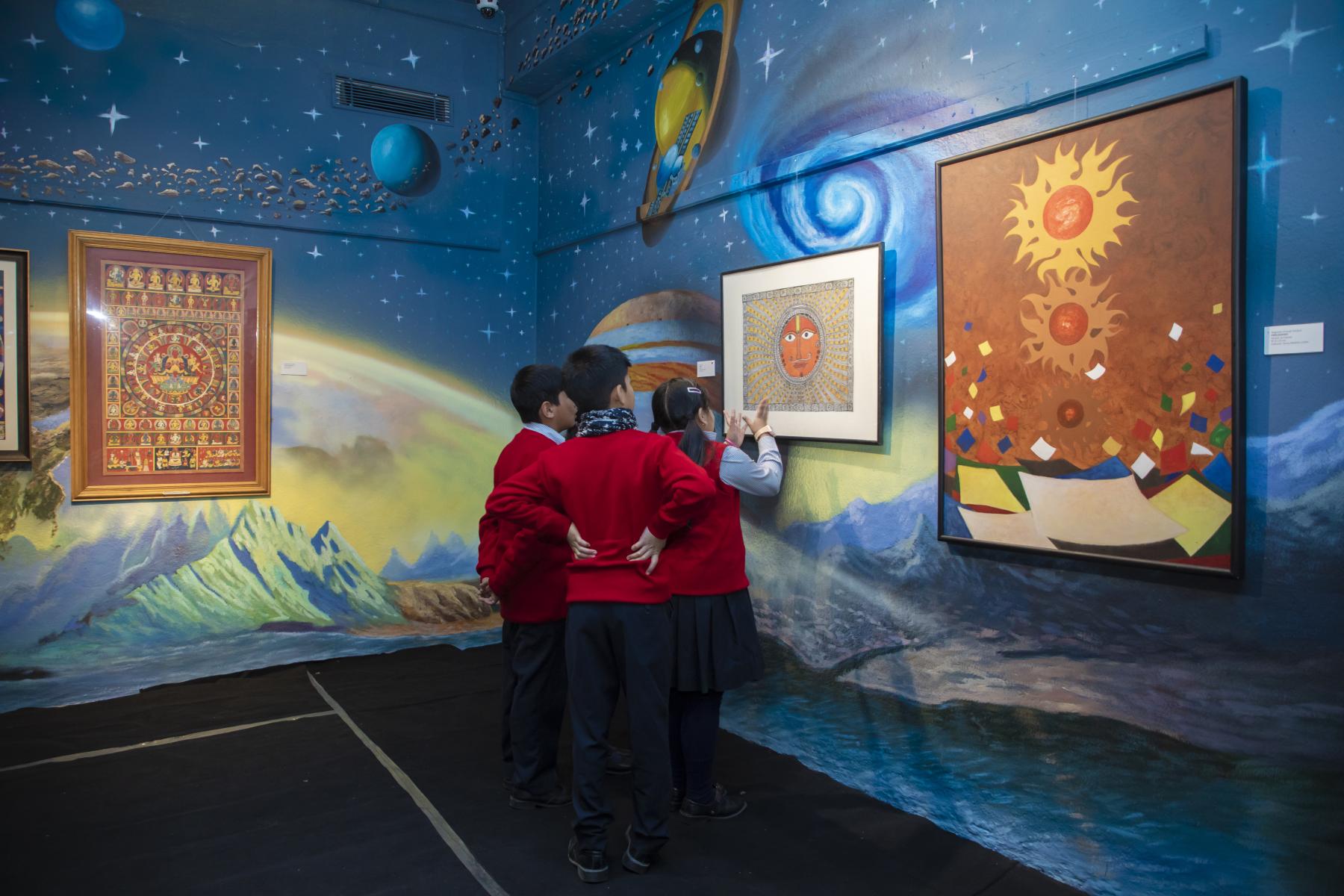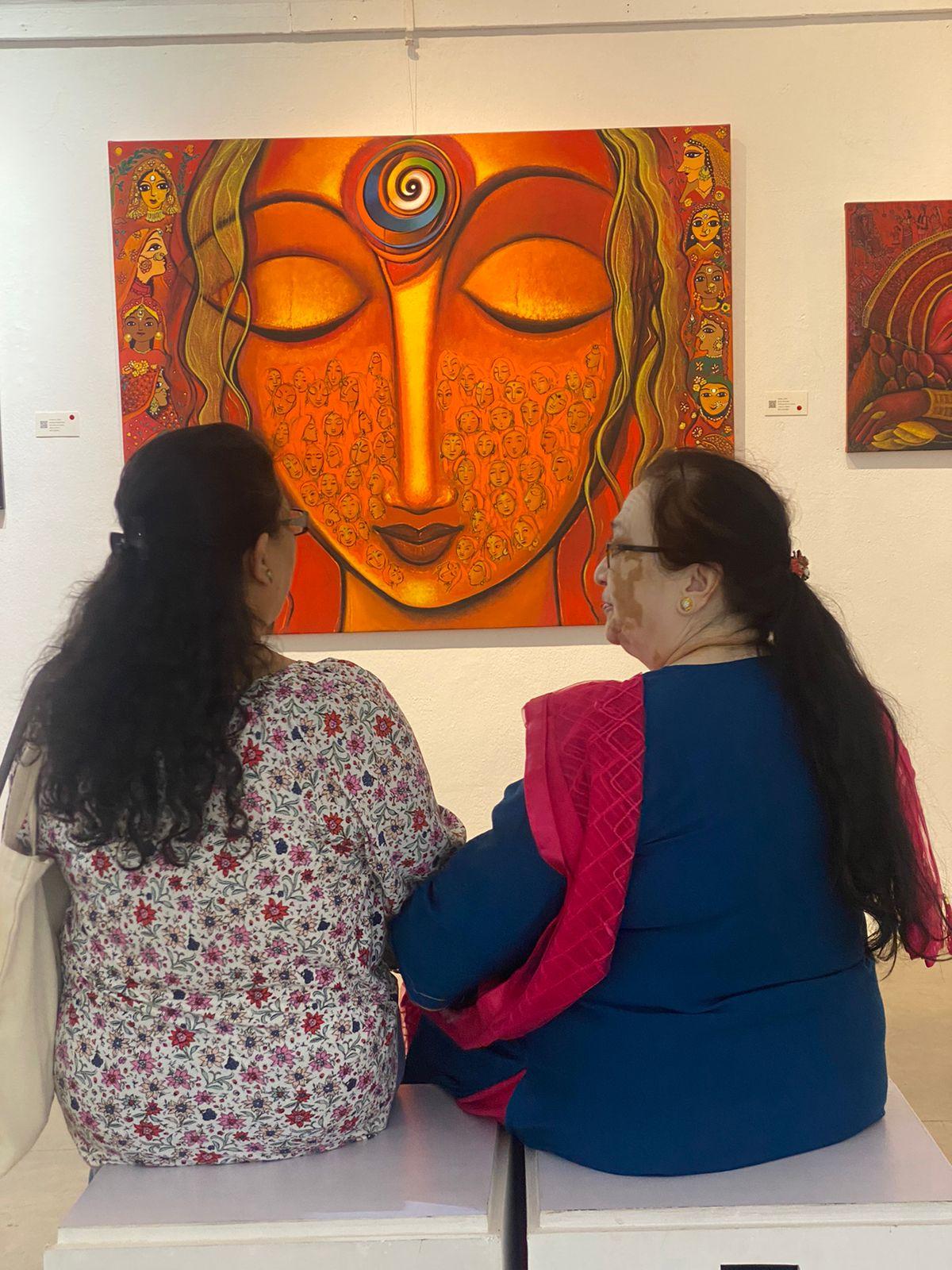The Nepali Art Scene: In Conversation with Swosti Rajbhandari Kayastha
Founded in 1962, the Nepal Art Council (NAC) is one of the leading art institutions in Nepal. Its curator, Swosti Rajbhandari Kayastha, reflects on the role of the organisation in providing a space to many of the major art exhibitions in the country. Kayastha started her journey at the NAC in 2014, when conversations around art were relatively scarce and public awareness was still nascent. In this edited conversation with Alfa M Shakya, she discusses the recent Deities of Nepal II exhibition held during May–June 2024 and provides an overview of the Nepali art scene in the last decade.

Visitors at Deities of Nepal II. The first floor of the exhibition had maps painted on the wall to give a sense of walking around Kathmandu Valley where there are temples all around.
Alfa M Shakya (AMS): NAC just wrapped up Deities of Nepal II, which was an ethereal exhibition featuring gods and deities. How did the idea for the first edition come about? Could you share your practice as a curator in Nepal’s growing but relatively young art environment?
Swosti Rajbhandari Kayastha (SRK): The Federation of Handicraft Association (FHAN) was celebrating their fiftieth anniversary and Nepal Art Council their sixtieth. FHAN approached us to do something together to commemorate the occasion. As curator, I wanted to bridge the distinction between handicraft and art. I also wanted to showcase diverse genres and techniques, such as contemporary art, wood, metal, Mithila, illustrations, etc., on a single platform. It occurred to me that the theme of deities is something that all artists work with. Everybody liked the idea. Sagar Rana, the president of NAC, suggested that the narrative of the exhibition can begin from the creation of the universe to the final destruction.
We received applications from 200 artists in response to the open call. As this was the first time a thematic exhibition at such a large scale was happening in Nepal, and that too with only Nepali artists, I put forward the idea to include all the artists who had applied as per the theme of the exhibition.
We planned the entire exhibition in three months, also focusing on education such as guided tours. James Giambrone from Indigo Gallery said that this was the best exhibition that he had seen in Nepal in the last fifty years. People were talking about the exhibition for a long time and that motivated us to do a sequel.

The third floor of Deities of Nepal II had a black room that Swosti Rajbhandari Kayastha used as an experiment for artwork placement.
AMS: What was different in the second edition?
SRK: In the first edition, the artists did not have sufficient time to create new work. This time, we gave them six months to create new work for the exhibition. We also received suggestions to explore more of the digital medium. So we had QR codes for each artist. We also had a digital immersive experience exhibit, “Lotus” by Fire Studios, where people were taking pictures, swimming, meditating and even dancing in the exhibition space.
While deities remained the main theme, we also included the abode of deities in this edition. Lok Chitrakar’s lotus painting was the first art piece I had selected for the second edition. I was expecting nature to be a running theme alongside the abode of deities and had planned the exhibition to feel as though one were walking in nature. But surprisingly, except for two or three art works, we did not receive many pieces depicting nature. The challenge with such thematic exhibitions is that while there might be a theme, we do not know what artists will send. For instance, we received a lot of temples and stone taps. I was in a dilemma about how to present them. However, when I was walking around Patan, it occurred to me that everything is everywhere—there is a big temple, a small temple, a stone tap, a stone that is being worshiped. The presentation was inspired by that realisation.

School students at Deities of Nepal I. Educational component was an important part of the exhibition with guided tours.
AMS: How would you say the second edition was received by the visitors and the art community?
SRK: People have now begun to say that Deities of Nepal is NAC’s patent exhibition. We had as many as forty schools visit us. But something that I saw for the first time was younger collectors, in their thirties or even younger than that, buying whatever their capacity allowed them to. I saw the grooming of the next generation of collectors.

Visitors taking a moment at Deities of Nepal II.
AMS: We have seen rising interest in Nepali art. There are more exhibitions, more artists and a lot more conversations happening. What do you think is the impetus behind it?
SRK: People are understanding the influence art can have over a person. Our education was visual in the past but over time we became very textual-based. We are now relearning the importance of visual-based education and visual communication. We are also beginning to work with the understanding that art does not only mean you have to limit yourself to painting. You can be a teacher, graphic designer, curator, interior designer, etc. The options are increasing and the value of art is being understood better.
AMS: What was your personal journey in the arts like?
SRK: My background is BFA in graphic design from Delhi University. I returned to Nepal and began practising. In 2004 or 2005, I began teaching at the KU School of Arts. My colleagues suggested that I write about Nepali art as there were only few writers writing in English about Nepali art. However, the challenge was that I had not studied in Nepal, but in Darjeeling. Art is related to history and culture, and I had no idea about these. I am also from Dharan and not from Kathmandu. I felt that it would be difficult. Veteran artist Madan Chitrakar suggested I study Nepali history and culture. From there, my journey took a different turn.
At NAC, they were looking for someone who knew fine art as well as Nepali history and culture. People who had studied both fields were very rare back then. Gopal Kala Premi, a senior artist, suggested that I join as a curator. I asked him, "What is a curator?” Few understood what a curator meant. I may be the first Nepali to officially use that designation.
The Nepali Art Gallery at Bihar Biennale became the second most visited gallery overall. (Photo by Bihar Museum)
AMS: You have seen how the art scene was a decade ago. You have also seen the progress that has happened in the last ten years. Where do you think are we headed next? What are some challenges that remain?
SRK: I think Nepal is doing a very good job. When we went to Vienna in 2019, our exhibition was hosted at their National Museum. This became one of the biggest platforms for Nepali art, as our exhibition was scheduled for six months. During its closing, a special art week was declared in Vienna. I saw this as an opportunity for Nepali art to extend its reach given that Vienna is a significant art centre in Europe. But Vienna Museum’s calendars are often booked for years in advance, and asking for an extension was a challenge. Eventually, the exhibition was extended for two more months. This happened because our art has the potential. Last year at the Bihar Museum Biennale 2023, NAC’s gallery became the second most visited gallery despite competition from G20 nations.
But there are hurdles too. Nepal does not have refined art policies. When NAC was going to the India Art Fair, we had to take the artworks through a very difficult process. You have to take art like any other commodity. There are no waivers for transportation. Due to all these challenges, we stopped taking part in the India Art Fair after participating for three years from 2016–18. The insurance rules for artworks are also unclear. For the Bihar Museum Biennale, the entire shipment of artworks and equipment, which costed around NRs. 1.5 crores, was sponsored by the museum.
The government’s intervention is much needed. We promote ourselves as a cultural destination, but what about the art that is the living culture? Otherwise, Nepali art is thriving and we can reach the international market.
Nepali Art Gallery at Bihar Biennale 2023. (Photo by Bihar Museum)
To learn more about exhibitions displayed at the Nepal Arts Council, read Shranup Tandukar’s essay on Amar Kanwar’s The Sovereign Forest.
All images courtesy of Swosti Rajbhandari Kayastha, unless mentioned otherwise.




